In Sheung Wan at Hong Kong Museum of Medical Sciences, Para Site (a prestigious center for contemporary art) presents a new off-site collective curated by Kobe Ko, entitled «Post-Human Narratives – In the Name of Scientific Witchery». Nine artists from Taiwan, Japan and Hong Kong, through their works, they tell about practices considered controversial or unorthodox by the scientific medical establishment; we move from genetic engineering to xenotransplantation, from dream analysis to healing through sound, up to ritual performances. On show we find the works of: Betty Apple, Ho Sin Tung, Mayumi Hosokura, Hui Serene Sze Lok, Florence Lam, Liv Tsim, Hou Lam Tsui, Ice Wong Kei Suet, and Bobby Yu Shuk Pui.
The Hong Kong Museum of Medical Sciences, a unique environment rich in history, hosts an exhibition that attempts to reconfigure new reflective narratives around science, magic and witchcraft.
Part of an ongoing project entitled «Post-Human Narratives», this collective is the third in a series of on-site and online reviews and initiatives that use post-humanist thinking as a starting point; it aims to enhance the stories of “magic” by challenging scientific rationality and focuses on the split between nature and man, between man and machine, between the empirical and the supernatural world.
«Scientific witchery» from the title comes from a text trace of a fantasy anime song, a reference that implies the ambiguous relationship between science, magic and witchcraft; such as before the advent and spread of Western medicine, sorcerers or shamans in various cultures had the role of healers.
The participating artists respond with fluidity to the contradictions evoked between past and present, between spells and wisdom and through videos, performances, sounds, installations and photography they show themselves to visitors free and without inhibitions.
We find the first work of the artist Bobby Yu Shuk Pui, a looped video reproduced on old generation monitors entitled The Top Bet, with a length of 10’38 ” and an installation entitled In search of receptionists composed from twelve wall photographs printed on porcelain and many and different elements positioned inside two large showcases, such as a uniform, a badge, the ready-made of some objects and an LCD. In both works the artist tackles the theme of human genetic engineering, declaring that she has always been attracted to it; he tells of human beings who use this technology to hide their physical defects and suppress their obsessions against the passage of time which unfortunately can become a very great and dangerous source of fear for man.
The video of the installation In search of receptionists, for example, talks about five receptionists working in a future genetic engineering salon, called Genetic Salon, a beauty company that offers high-quality genetic modifications. The story tells of these girls who secretly use the means of this salon to transform themselves into plants, in order to reduce daily expenses and better manage the waste of time; one of them is suspected of selling beauty services on the black market, causing customers a nasty side effect: memory loss. This video is certainly the vision of a sick future for humanity, made up of extreme and exaggerated practices that want to exorcise our daily life.
Walking through the white walls of the museum, we discover Betty Apple‘s sound installation from 2022 entitled Frequency purification guide. The work places vibrators in the shape of bullets at the center, in a transparent red plexiglas box, these symbolize sexual ecstasy, the contemporaneity of living our sexuality, the fetish of the object and feminine energy; connected to them on the sides, again in plexiglass boxes, some speakers transmit the frequency of the vibrators through a magnetic microphone. The artist, as if it were a healing white magic, leads the public on a journey of purification through a 15’ audio guide. As Nikola Tesla said: «If you want to discover the secrets of the universe, think in terms of energy, frequency and vibration».
In the same room we see the installation by Mayumi Hosokura composed of a video on monitor positioned at the bottom on the floor, entitled Sensui(diving) and a diptych made up of two cyanotype prints on cotton (sewn, patchwork type) entitled Sanpo(stroll) #1, #2, place one to the right and one to the left of the monitor. The video is a collection of instant photos of the artist, including body images and fragments of rubbish that the artist himself collected during his walks; the two photographs alongside are instead the reproduction of multiple screenshots captured by the Sensuivideo, stitched together. A «reworked body map» is thus created, transported into the digital world. This work is also an experiment on how to transform objects into images (such as in the video) and images into objects (such as in the diptych).
In the mysterious space of the museum we come across Liv Tsim‘s work entitled Sacrifice, prescription, and implantation of 2022. The work is composed of various mixed media sculptures (glycerin, chitosan powder, calcium carbonate powder, stainless steel, artificial pigments and an electrical device), among these we find the reproduction of two hearts. Here the work dialogues with medicine, with its evolution and with the development of transplants, specifically with xenotransplantation, where the change from the past to the present is highlighted. Where once various animal organs were recognized as sacred and used to expel demons and consequently heal diseases, today they are seen as elements of healing through medicine, as happened this year, 2022, at the Maryland Medical Center, where he was transplanted a genetically modified pig heart to a patient, resulting in the longest survival for a xenograft recipient (two months).
Another work by Liv Tsim, with the collaboration of Ice Wong Kei Suet, consists of a series of four photographic prints in cold tones and linked to the colors of the night, entitled Imitation to synchronize. Elaborated and created with oscillatory movements, the works appear abstract as if they were painted canvases; conceptually, the two artists ask themselves if the life of ordinary people and therefore of the mass is evolving or simply rewinding.
Continuing to walk we find the installation by Ice Wong Kei Suet entitled That nigh, the echoes of Lisea’s song sounded across the ocean. On a table are placed many small tape with the exact date and time of the recording, resting on small cushions, a bulletin board with notes and a radio with headphones. On the windows, instead of the prints, they cover most of the glass which from transparent become abstract decorative elements, visually forming the movement of the ocean waves; only the upper part of the glass is not covered, so that during the period of the exhibition, the various phases of the moon can be seen from the outside. Here the artist speaks conceptually of the dream and explains that, despite many scientific and psychological studies, the succession of emotions and sensations that occur during its development is still not fully understood today. As soon as she wakes up, the artist records on tape all the narrations of her dreams, in the hope of having a concrete explanation from the viewer on their meaning.
The work of the artist Florence Lam entitled Berth continues, twenty-six small-format images protected by plexiglass frames positioned in a pyramid shape. Many black and white prints and a photo etching in warm colors on top of all, depict the artist’s uterus ultrasound. In the 1950s the doctor and astrologer Eugen Jonas found in some Assyrian cuneiform writings, clues that suggested that female fertility was influenced by the energy generated by the lunar cycle and would thus explain why some women conceive even in scientifically unusual moments, such as example in the period of menstruation. On May 16, 2022, during the full moon in the «spring flowering period», also known as «Flower moon» or «Mother ‘s moon», the artist made an ultrasound of her uterus and printed it as an engraving. The image was captured during the period of menstruation, where the flow alludes to the waves of the sea. Florence Lam sees the uterus as a magical organ for the creation of life, the soul of a creature inside the womb represents life before coming into contact with the world and therefore unfortunately inevitably sooner or later with death.
Another work by the same artist is Zirka (“incandescence”), a performance lasting about an hour. The idea was born when during a process of meditation, passing from the unconscious to the conscious, she saw herself wearing a «bib» armor with feminine shapes; in this regard, she makes this armor to use it during the execution of artistic rituals and, as magical rites against conspiracies, she performs her prayer actions. Zirka means «small star» in ukrainian and in the artistic context the natural phenomenon of incandescence is seen as a prayer for a small distant star.
In another room of the museum you can see the elegance and power of Ho Sin Tung‘s multiple works, including the photographs entitled More than two, two 70×50 cm prints and one of 30 x 21 cm. The work stems from an anecdote by the artist, where once a fortune-teller told her: «A woman shouldn’t have more than three flowers on her head, since the Chinese character of the word Flower has only two on top». The artist was inspired by this concept, she looked for flowers in the house and placed them on her head, thus creating a perfect set for the realization of her elegant works of hers.
We come to the magical works of Hou Lam Tsui that certainly take us back to childhood and adolescence. The soap sculptures customized with a hot process called Magic soap, are many small magic wands of the mahō shōjo (“magical girl”) genre placed in drawers, inside a sink or in a cupboard. Magic soap blurs the line between what is classified as science and what is not, mixes the concept of magic (unstable and threatening) with science (stable and manageable). Here the mahō shōjo genre therefore has a fluid meaning, made up of positive, fantastic and carefree images. Accompanying the magic wands are two other works: a video and a printed diary. The video entitled Crystal foam placed inside a drawer, plays in sequence various clips of commercials of anime and soap operas of the mahō shōjo genre and shows the commodification of the female body through the consumerism in the mass media. In the video, waving a wand and taking a shower are actions that repeated become disturbing and the transformation tool (the magic wand) and the soap become an important link between the two identities of the magical girl, that of the common person and that of the warrior. The work entitled Glitter Ash, on the other hand, is an artist’s diary made up of notes, drawings and small adhesive gold stars, linked to witchcraft, magic and the whole concept of his works.
At the end of the journey we come across the works of Hui Serene Sze Lok, a trilogy made up of written and evoked words, female songs and voices entitled Scold, gossip and siren. Videos, performances and letters are mixed to enhance the artist’s autobiographical work, where the thin line between public and private breaks and the artist’s voice is given to the public, like a siren gives her song. Her whole project is very complex and she proposes the exaltation and power of magical languages as elements of refuge and salvation.
«Post-Human Narratives – In the Name of Scientific Witchery» is more than an exhibition, it is a story made of magic, superstition and links with the supernatural, where the atmosphere appears positive and the hope of realizing one’s dreams, thanks to magic, becomes reality.
Benedetta Spagnuolo
Info:
Post-Human Narratives – In the Name of Scientific Witchery
30/07 – 28/08/2022
Hong Kong Museum of Medical Sciences
2 Caine Lane, Sheung Wan
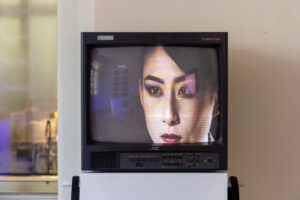 Bobby Yu Shuk Pui, The Top Bet, 2022, video 10’38’’, photo credit Wong Pak Hang @Studio Lights On, courtesy Para Site
Bobby Yu Shuk Pui, The Top Bet, 2022, video 10’38’’, photo credit Wong Pak Hang @Studio Lights On, courtesy Para Site
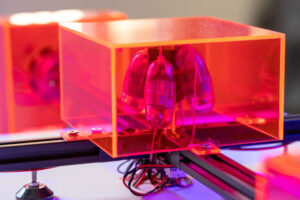 Betty Apple, Frequency purification guide, 2022 installation guide, variable dimension, photo credit Wong Pak Hang @Studio Lights On, courtesy Para Site
Betty Apple, Frequency purification guide, 2022 installation guide, variable dimension, photo credit Wong Pak Hang @Studio Lights On, courtesy Para Site
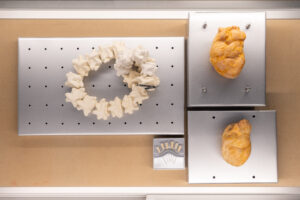 Liv Tsim, Sacrifice, prescription and implantation, 2022. Mixed media, glycerine, chitosan powder, sodium alginate, pine resin, calcium carbonate powder, pancreatin, collagen protein powder, artificial pigment, stainless and electrical device , photo credit Wong Pak Hang @Studio Lights On, courtesy Para Site
Liv Tsim, Sacrifice, prescription and implantation, 2022. Mixed media, glycerine, chitosan powder, sodium alginate, pine resin, calcium carbonate powder, pancreatin, collagen protein powder, artificial pigment, stainless and electrical device , photo credit Wong Pak Hang @Studio Lights On, courtesy Para Site
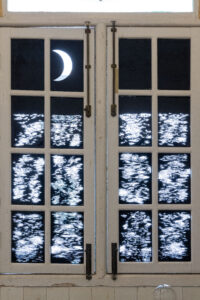 Ice Wong Kei Suet, That night, the echoes of Lisea’s song sounded across the ocean, 2022. Mixed media installation, variable dimension, photo credit Wong Pak Hang @Studio Lights On, courtesy Para Site
Ice Wong Kei Suet, That night, the echoes of Lisea’s song sounded across the ocean, 2022. Mixed media installation, variable dimension, photo credit Wong Pak Hang @Studio Lights On, courtesy Para Site
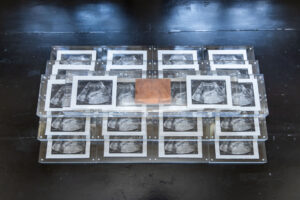 Florence Lam, Berth, 2022, photo etching, photo credit Wong Pak Hang @Studio Lights On, courtesy Para Site
Florence Lam, Berth, 2022, photo etching, photo credit Wong Pak Hang @Studio Lights On, courtesy Para Site
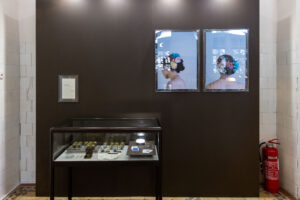 Ho Sin Tung, More than two, 2022, photograph, a set of 3 Edition of 5, 2 70 x 50 cm, 1 30 x 21 cm, photo credit Wong Pak Hang @Studio Lights On, courtesy Para Site
Ho Sin Tung, More than two, 2022, photograph, a set of 3 Edition of 5, 2 70 x 50 cm, 1 30 x 21 cm, photo credit Wong Pak Hang @Studio Lights On, courtesy Para Site
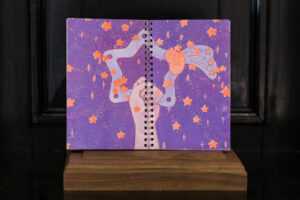 Hou Lam Tsui, Glitter Ash, 2022, printed matter, 19 x 21 cm, photo credit Wong Pak Hang @Studio Lights On, courtesy Para Site
Hou Lam Tsui, Glitter Ash, 2022, printed matter, 19 x 21 cm, photo credit Wong Pak Hang @Studio Lights On, courtesy Para Site
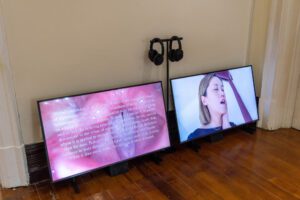 Hui Serene Sze Lok, Scold, gossip and siren, 2022, two-cannel video in colour, with audio, on loop. 11’44’’ and 13’32’’, photo credit Wong Pak Hang @Studio Lights On, courtesy Para Site
Hui Serene Sze Lok, Scold, gossip and siren, 2022, two-cannel video in colour, with audio, on loop. 11’44’’ and 13’32’’, photo credit Wong Pak Hang @Studio Lights On, courtesy Para Site
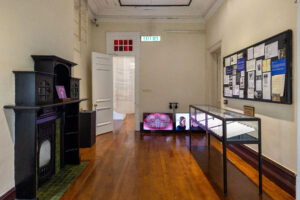 AA. VV., Post-Human Narratives – In the Name of Scientific Witchery, installation view at Hong Kong Museum of Medical Sciences, photo credit Wong Pak Hang @Studio Lights On, courtesy Para Site
AA. VV., Post-Human Narratives – In the Name of Scientific Witchery, installation view at Hong Kong Museum of Medical Sciences, photo credit Wong Pak Hang @Studio Lights On, courtesy Para Site
She graduated at the Academy of Fine Arts in Catania. During her lifetime, she has experienced various arts including sculpture, theatre, dance and photography, and the latter one became the springboard for her eclectic and innovative artistic path. In 2010, she approached the art curatorial world and started to write reviews and critical texts; later, she founded “Artisti Italiani – arti visive e promozione”, an organisation which deals with all the promotional aspects of contemporary art.






NO COMMENT